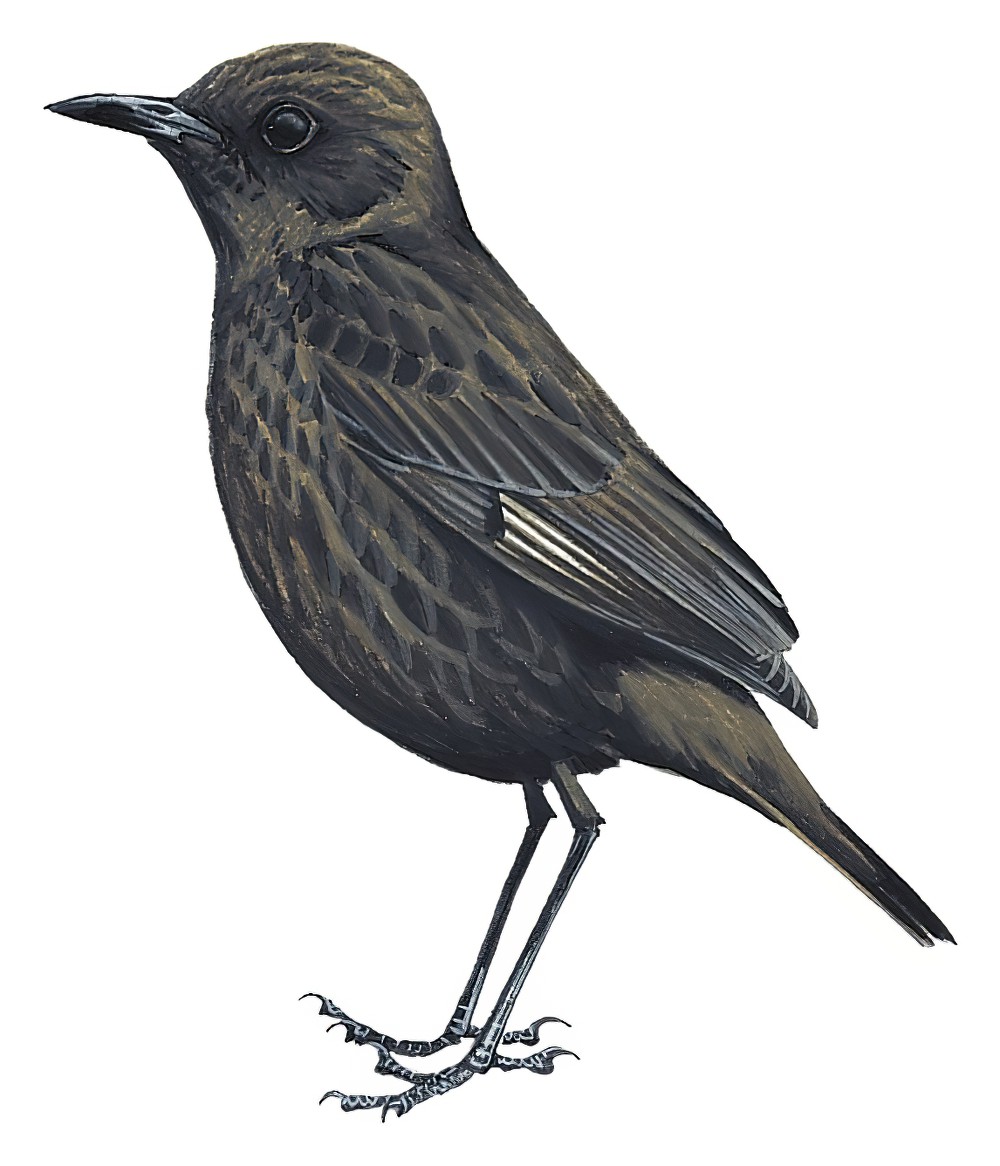Southern Anteater-Chat / Myrmecocichla formicivora

Southern Anteater-Chat
SCI Name:
Protonym: Motacilla formicivora Nouv.Dict.Hist.Nat. 21 p.421
Taxonomy: Passeriformes / Muscicapidae / Myrmecocichla
Taxonomy Code: soacha1
Type Locality: Pays des Cafres = Sunday''s River, eastern Cape Province, ex Levaillant, 1805, Oiseaux Afrique, 4, pis. 186, 187.
Author: Wilkes
Publish Year: 1817
IUCN Status: Least Concern
DEFINITIONS
MYRMECOCICHLA
(Muscicapidae; Ϯ Southern Anteater Chat M. formicivora) Gr. μυρμηξ murmēx, μυρμηκος murmēkos ant; κιχλη kikhlē thrush; "Le MOTTEUX FOURMILIER, Œnanthe formicivora, Vieill. ... Le nom de fourmilier que M. Levaillant lui a imposé, vient de ce qu'il se tient plus particulièrement dans les plaines où les fourmis élèvent de petites monticules, sur le haut desquelles il aime à se percher; il se nourrit aussi de leurs larves." (Vieillot 1818); "Gen. MYRMECOCICHLA nov. gen. *) Ameisenschmätzer. 52. 1. M. formicivora Nob. — Traquet fourmillier Le Vaill. tab. 186.87. Sylvia formicivora Vieill. Encycl. méth. No. 210. ... *) Von μυρμηξ, Ameise; Kιχλη, Drossel; der gebognere Schnabel, die kürzern nicht zugespitzten Flügel und die viel stärkeren kräftigeren Beine mit höheren Läufen und stärker entwickelten Nägeln sind für sich schon genügende Unterschiede dieser Gruppe von Monticola. Als weitere Arten gehören hierher: 1) M. aethiops Nob. Turdus aethiops Licht. Mus. Berol. vom Senegal. ... 2) M. nigra Nob. Saxicola nigra (Vieill.) Traquet Commandeur Le Vaill. Ois. d'Afrique tab. 189." (Cabanis 1853); "Myrmecocichla Cabanis, 1850 [= 1853], Mus. Hein., 1, p. 8. Type, by subsequent designation (Gray, 1855, Cat. Gen. Birds Brit. Mus., p. 35), Oenanthe formicivora Vieillot." (Ripley in Peters 1964, X, 115).
Synon. Dromolaea.
FORMICIVORA
(Thamnophilidae; Ϯ Southern White-fringed Antwren F. grisea) L. formica ant; -vorus -eating < vorare to devour; "It is at this stage of our progression that I propose to fix the limits of Thamnophilus, and pass into the genus Formicivora: here the bill is no longer robust; but narrow, slender, and more cylindrical; the under mandible weak, and the gonix nearly strait; the tail of some species is even longer and more cuneated than in the last group" (Swainson 1824); "FORMICIVORA. Rostrum mediocre, subcylindraceum, gonyde recta; vibrissæ nullæ. Alæ breves, rotundatæ, remige 4ta vel 5ta longissima. Cauda gradata. Tarsi mediocres, graciles; squamis lateralibus frequentibus. ... The Formicivoræ or Ant-Wrens, are all of them very small; and in an artificial arrangement might very well be associated with the Warblers. In all but their slender bill, they present a perfect miniature resemblance to the true Thamnophili, even to the lateral scales of their tarsi, which are small and numerous. They differ from the Drymophilæ by their comparatively short legs, which are obviously not intended for walking. We know little of their natural economy, further than that they frequent bushes and the low branches of trees, which they probably cleanse of those small insects, passed over by their more powerful brethren. ... 1. FORMICIVORA maculata. White-spotted Ant-Wren. ... 2. FORMICIVORA nigricollis. Black throated Ant-Wren. ... 3. FORMICIVORA brevicauda. Short tailed Ant-Wren." (Swainson 1825); "Formicivora Swainson, Zool. Journ., 1, 1824, p. 301, in text. Diagnosis only; species added, Swainson, Zool. Journ., 2, 1825, p. 145-149. Type, by subsequent designation, Formicivora nigricollis Swainson = Turdus griseus Boddaert (G. R. Gray, List Gen. Bds., 1840, p. 25)." (Peters, 1951, VII, p. 206).
Var. Formicivor.
Synon. Myrmecophila, Neorhopias, Stymphalornis.
formicivora
L. formica ant; -vorus -eating < vorare to devour.
● ex “Traquet Fourmilier” of Levaillant 1806, pl. 186 (Myrmecocichla).
UPPERCASE: current genus
Uppercase first letter: generic synonym
● and ● See: generic homonyms
lowercase: species and subspecies
●: early names, variants, mispellings
‡: extinct
†: type species
Gr.: ancient Greek
L.: Latin
<: derived from
syn: synonym of
/: separates historical and modern geographic names
ex: based on
TL: type locality
OD: original diagnosis (genus) or original description (species)












